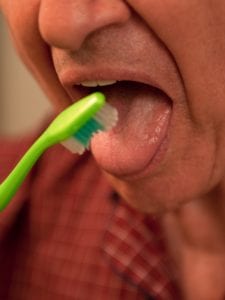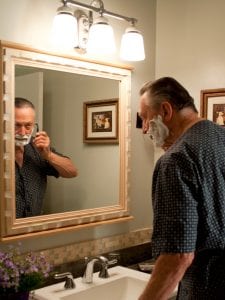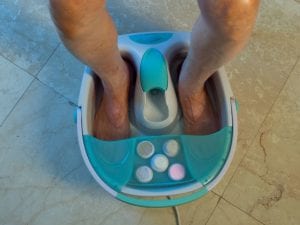Welcome to the educational program Assisting with Activities of Daily Living: Grooming. This program will present principles for assisting people with Alzheimer’s disease to perform activities of daily living, also called ADLs or self-care activities, with a focus on grooming activities. It will help you understand the factors that can make grooming challenging for individuals with Alzheimer’s and their caregivers; and provide strategies for assisting with grooming.
The grooming topics covered in this program include oral care or hygiene, hair care, shaving, nail care and foot care.
. . .
This is Lesson 5 of The Alzheimer’s Caregiver. You may view the topics in order as presented, or click on any topic listed in the main menu to be taken to that section. We hope that you enjoy this program and find it useful in helping both yourself and those you care for.
There are no easy answers when it comes to the care of another, as every situation and person is different. In addition, every caregiver comes with different experiences, skills, and attitudes about caregiving. Our hope is to offer you useful information and guidelines for caring for someone with dementia, but these guidelines will need to be adjusted to suit your own individual needs.
Remember that your life experiences, your compassion, and your inventiveness will go a long way toward enabling you to provide quality care.
Let’s get started.
Prefer to listen to this lesson instead? Click the Play button below.
Aging Factors

Alzheimer’s disease typically affects people in their older years, so the changes associated with aging, as well as dementia, must be taken into consideration. Aging factors that affect bathing include the person’s skin, which becomes thinner and more fragile, making it easier to bruise or injure. The body’s temperature regulating system declines with aging, so older people are more sensitive to temperature, particularly to cold. They may feel chilled even when others feel warm. Due to declining vision and hearing, older people may not be able to hear instructions well or see things clearly, such as the hot and cold labels on water taps. With aging, joints can become stiff and painful, which can limit motion and cause unsteadiness. This is especially important because falls become a greater risk due to reduced mobility and balancing ability.
Dementia Factors

In addition to aging, changes associated with dementia also contribute to loss of functionality. Dementia causes memory loss, or amnesia. This loss of memory initially involves predominantly short-term memory, such as where they put their slippers or when they last had a bath. Over time, the memory loss includes more and more distant memories. Automatic skills, such as bathing and brushing teeth, are also gradually forgotten due to damaged brain cells. The loss of automatic skills or inability to use common objects is called apraxia.
Recognition, or the ability to recognize images, also declines as Alzheimer’s progresses. For example, the person may not recognize a bottle of shampoo or washcloth. This inability to recognize objects is called agnosia.
Alzheimer’s disease also affects the language centers of the brain. So the person will have increasing difficulty understanding and creating speech. This is called dysphagia or aphasia.
Attention and concentration decline as well. As Alzheimer’s progresses, the ability to pay attention and concentrate on a task gradually decreases.
Stress threshold recognition declines, meaning that people with Alzheimer’s often do not know when or how much they are stressed. They also have a lower threshold for stress, so they feel stress more easily. Their ability to avoid stress also decreases, and they cannot anticipate when stress may increase.
Impulse control declines.The ability to control one’s impulses is called the executive function. Alzheimer’s causes damage to the front part of the brain, which controls executive function. Poor impulse control can lead to yelling, fighting, hitting, pinching, or throwing things.
Additionally, organizational ability declines. Damage to the front part of the brain also results in loss of organizational ability. Self-care activities require organizational ability: that is, knowing what to do, when to do it, and how to put prepare the necessary items.
Lastly, people with dementia can have difficulty adjusting to new surroundings, which may cause confusion, fear, and a negative reaction to performing activities of daily living. When planning and assisting with ADLs, you should consider whether the person is in an unfamiliar environment, such as a long-term care facility.
Factors That Affect Grooming

Grooming requires a multitude of abilities that includes fine motor skills, such as those needed for shaving or putting on makeup. It also requires gross motor skills like the ability to comb hair. It requires memory skills, such as remembering where grooming items are, as well as the ability to perceive the position of one’s arms and legs. All of these abilities decrease as Alzheimer’s disease progresses.
A combination of additional factors associated with dementia can reduce the ability to groom oneself. This includes agnosia, or not recognizing objects or the environment; apraxia, which is the inability to automatically perform learned skills or connect what one intends to do with the actions needed to do it. Examples of apraxia include forgetting how to eat, dress, bathe, brush teeth, and walk. Dementia also causes a loss of organizational, planning and decision-making skills.
In one model of behavior, all behaviors are considered to be responses to stimuli in the environment. This model explains how people with dementia try to make sense of their world and do what is expected of them by reacting mechanically to stimuli in their environment. For example, if a doorknob is in front of them, they grasp it. If there is an open door, they go through it. Based on this principle, caregivers can increase the likelihood of getting a response by setting up stimuli in the environment for that response. On the other hand, caregivers can decrease the likelihood of a difficult behavior by removing stimuli that may lead to that difficult behavior.
Activities of Daily Living (ADLs)

One way of looking at assisting with activities of daily living or ADLs is to think of them as opportunities to spend more quality time with the person. Performing ADLs is basic to one’s sense of dignity, autonomy, and mastery. Loss of these abilities can lead to frustration, embarrassment and a sense of inadequacy. In addition, fear and frustration associated with ADLs are the source of most difficult behaviors. For these reasons, it is extremely important that caregivers approach ADLs with understanding and compassion, as this will go a long way toward preventing behavior difficulties and improving the quality of life for the caregiver and care recipient.
When assisting with ADLs such as dressing, caregivers should use an understanding and compassionate approach. Show patience, a sense of humor, and a positive attitude. Offer plenty of reassurance, positive affirmation, and never scold the person. It is important not to humiliate those with dementia with reminders that they need assistance. Instead, provide a positive atmosphere by using a calm tone of voice, an easy smile, and a sensitive, patient approach. People like to hear compliments about their appearance, so be generous with your compliments. And don’t forget that humor can help overcome and lighten a difficult or embarrassing situation.
Caregivers should take into consideration a person’s physical disabilities (such as weakness, fatigue, pain and joint stiffness) and sensory impairments (such as visual or hearing loss) when planning and assisting with ADLs. By adjusting and simplifying activities to the person’s abilities, caregivers can increase the likelihood of success. If handled well, caregivers can help those with dementia express their independence and build their self-esteem through ADLs.
It is important for caregivers to know and respect their care recipients and their personal preferences. Find out what their preferred routine is for dressing. This is referred to as person-centered care.
Person-Centered Care
Person-centered care focuses on the person. It considers their comfort and preferences and addresses unmet needs.

Agitation during dressing can occur when the caregiver is focused on the task rather than considering the comfort and preferences of the care recipient.
An important principle in any care-related activity is referred to as person-centered care as opposed to task-focused care. The behaviors such as agitation or combativeness need to be seen as expressions of unmet needs rather than oppositional behavior. Person-centered care considers the person’s history, feelings, preferences, abilities, strengths and needs.
If individuals become anxious and reluctant to get dressed, ask them (or try to determine from their body language) what might be frightening them or what they might need. They may need to use the toilet or may be having pain that is worsened by movement.
By gathering information and applying your knowledge about individuals, you empower yourself with the ability to create positive strategies that can enhance their quality of life.
Principles for Assisting with ADLs
Here are some general principles for assisting someone with activities of daily living, such as dressing.
Remember that an attractive appearance is important to self-esteem, and dressing is a great opportunity to promote autonomy and independence, and increase self-esteem for the person with dementia. Maximize individual abilities and minimize disabilities by encouraging self-care rather than doing the activity for them. Encourage people to use their remaining abilities by doing as much for themselves as possible while maintaining their safety and security. Reinforce effort and show appreciation by giving praise for both successful and unsuccessful efforts.
Because dressing is such a personal activity, caregivers need to allow individuals to do as much for themselves as they are comfortable and capable of doing. For example, caregivers should always offer to let the persons put on their own undergarments. If it is necessary for caregivers to assist with those things, they should always ask permission. One can say something like, “It’s time to put on your undergarments, is it alright if I help you put on your bra?” Give the person choices appropriate to the level of the person’s abilities, but not so many that they become frustrated. Examples of choices include what color sweater or skirt wear.

Provide cues and prompts for the person, but only when needed and without taking over. Offer reminders, such as the next step of an activity, if they seem to have forgotten. Also offer practical help. For example, help the person open and apply the toothpaste on the toothbrush, or place a comb in the person’s hand, as this may help cue the person to use it. If that doesn’t work, try demonstrating the step if necessary, as watching someone perform a task can sometimes prompt a person with dementia to imitate it. For example, comb your own hair if the person seems confused about what to do with a comb. Although it may be difficult to watch others struggle through an activity, it is better to let them try it and offer help only when they need it. So use hand-over-hand guidance only when necessary and with permission. Allow plenty of time for the activity. Do not rush, as the person can pick up on the emotional tone and feel frustrated.
Principles for Assisting with ADLs (Continued)

Use effective communication skills such as gaining eye contact, speaking clearly and slowly, and using familiar terms. You may need to repeat things and offer reminders. Say the important word last, as people are more likely to remember the last thing that is said. Break up activities into simple steps and give just one or two instructions at a time. For example, say, “Here is your shirt, please put it on.” Then say, “Here are your pants, please put them on,” as you hand each item to the person. In addition, observe body language for comprehension and comfort.
Adapt your instructions based on the functional and cognitive levels of the person, remembering that these levels may fluctuate. Plan the activity to allow the person to succeed by simplifying the steps to fit her or his remaining abilities.
Set reasonable expectations for appearance, as being too fussy about appearance will only add unnecessary stress to everyone involved.
Always insure the person’s privacy while dressing, making sure that doors are closed and blinds are drawn.
Provide adequate lighting in rooms, making sure that there is sufficient overhead lighting as well as good task lighting from a desk or floor lamp.
Make sure that there are no distractions in the room, such as noise, clutter, or other people.
Lastly, don’t argue or force the person to do something. If people remain insistent about choices that are not harmful to themselves or others, leave them alone. If changing their mind is important, try using distraction to move onto another topic. Then try the dressing activity again later when they may be more accepting of the idea.
Engage and Use a Relaxed Style
Now, let’s discuss how to engage someone and use a relaxed tone and style of instruction.
First, focus your attention on the person. When talking to individuals, face them, get their attention, and address them by their preferred names. Don’t assume that they like nicknames or terms like, “honey’ or “sweetie.” If you are hovering or talking with someone else while you are assisting your care recipient, your directions will not register with the person.
Use relaxed body language and tone of voice. Remember that the person may understand your body language better than your words, so smile and try to convey a relaxed, easy-going attitude. Use gestures and expressions to help communicate your message.

Give simple, step-by-step instructions that match the person’s level of understanding. Say the important words or instructions last, as this will make it easier for the person to remember.
Encourage the person to do as much as they can, even if that means simply cooperating with your caregiving efforts. Praise them for effort and cooperation. You can say things like, “You did a great job brushing your teeth. Your smile looks so bright with your clean teeth.”
Lastly, if you are assisting dressing, explain what you will do before each step.
Oral Care
Let’s start with the topic of oral care.
People with dementia are at high risk for dental problems due to decreased salvia production, sugar-based medications that may cause tooth decay or dry mouth, poor eating habits, and reduced ability to care for their own teeth or dentures.
Oral care, or care of the teeth and mouth, consists of more than just brushing teeth. It includes cleaning between teeth, cleaning the tongue, and rinsing the mouth on a regular basis. If the person wears dentures, caregivers need to make sure that the dentures are cleaned and well-maintained. Adequate hydration and visits to a dentist are also important parts of oral care.
Case Study 1
Let’s examine a case study about Mary and her husband, Robert, who has Alzheimer’s disease. Robert still has most of his own teeth, but has had sore gums from time to time. Mary’s working with him to correct this problem. What was going on in this scene?- A. Robert wanted to do his own care, but he could not remember how to brush his teeth.
- B. Robert could not distinguish between a toothbrush and a hairbrush.
- C. Mary hurts Robert’s feelings by scolding him.
- D. All of the above.
Answers:
Choice A: “Robert wanted to do his own care, but he could not remember how to brush his teeth” is a good answer.
After a long life of self-care, there is a strong desire to do these private activities for oneself. So whenever possible, individuals should be encouraged to carry out their own self-care activities. But Robert has lost the ability to perform the actions needed to brush his teeth. He found a toothbrush but was not sure what to do with it. This is an example of apraxia — Robert has difficulty connecting the thought or desire to brush his teeth with the actions needed to carry it out.
Choice B: “Robert could not distinguish between a toothbrush and a hairbrush” is also a good answer.
Damage to the part of the brain that recognizes objects, people, and places makes it difficult for Robert to recognize and distinguish various grooming articles. He can see the toothbrush and hairbrush but may not recognize their differences and their different functions.
Choice C: “Mary hurts Robert’s feelings by scolding him” is also a correct answer.
Robert was trying to do the right thing. When the ability to comprehend words declines, people with dementia rely more on reading body language and tone of voice. Mary’s body language, tone of voice, and words clearly conveyed disapproval and irritation. People with dementia are more sensitive to scolding because their self-esteem and sense of dignity are already compromised. They may become discouraged, anxious, angry, or combative.
Choice D: In this case, if you chose Choice D, “all of the above.” You are correct.
Case Study 1 Tips
There are several different approaches that Mary could have used to assist Robert with his oral hygiene. Mary could have made sure that there was only a toothbrush beside the sink when Robert was ready to brush his teeth. People with dementia can get confused and have difficulty distinguishing and focusing on one object when too many objects are in front of them. If you want to provide a choice, consider setting out two toothbrushes of different colors.

Mary could have used hand-over-hand guidance to enable follow-through in tooth brushing. Some activities may be difficult to get started, but once the activity is in motion, the body may automatically complete it. Mary could have placed the toothbrush with toothpaste in Robert’s hand, held his hand with the toothbrush, and gently lifted it to his mouth. Mary could have praised his effort, whether his attempt was successful or not. Praise encourages people and builds self-esteem. Keep in mind that people with dementia have an ever-declining sense of mastery of their environment, and often face frustrations, failures, and inadequacies. So it is important for them to hear that their efforts are appreciated.
Case Study 2
Let’s watch Mary try some of these approaches with Robert.Strategies for Managing Oral Care

These are some strategies for helping those with dementia manage their oral care.
First, plan and prepare the necessary items and the environment.
Second, use cueing and prompting if needed.
Next, try to observe a regular routine. This includes maintaining healthy oral hygiene practices and scheduling regular dental care.
Let’s discuss each of these topics in more detail.
Prepare the Equipment and Environment

Here are some tips for planning and preparing the items and environment for oral care.
First, have the necessary items (such as toothbrush, toothpaste, cup for water, and towel) set out in order of use or be ready to bring them out as needed. For brushing natural teeth, a soft toothbrush bent at an angle may be easier for the person to use. An electric toothbrush can also be helpful if the person tolerates it. On natural teeth, use fluoride-containing products, such as toothpaste, mouthwash, and fluoridated water. You should also select toothpaste with a flavor that the person likes. Mouthwash is also very helpful for preventing cavities and gum disease. Select a mouthwash with color, so that it will not to be confused with water. Do not set out the whole bottle of mouthwash, but rather, place a small amount in a cup in case the person tries to drink it. If the mouthwash is too strong to tolerate, try diluting it with water, or select a brand that the person tolerates best.
Keep the number of items by the sink to a minimum, as too many items may confuse the person and result in frustration and failure.
Take into consideration the person’s physical and cognitive abilities. For example, if someone has impaired hearing, be sure to speak clearly and stand so that the person can see your face. If someone has left-sided weakness from a stroke, be sure supplies are close to the person’s “good” side. As dementia progresses, the person may have difficulty gripping the toothbrush, so routinely check how well the person can grip the handle. There may be adapted toothbrushes that the person finds easier to hold.
Lastly, to reduce fatigue, place a comfortable chair in front of the sink for tooth brushing and other grooming activities.
Cueing and Prompting
If the person is confused or hesitates, try using cueing and prompting. These are simply nudging techniques to help the person focus and proceed through the necessary steps of an activity. Cueing is usually a visual method, whereas prompting is usually verbal.
A cue can be the caregiver picking up the toothbrush and putting toothpaste on it, or even a picture of someone using a toothbrush.
Demonstration is a good method of helping those with dementia who may have forgotten how to perform tasks but are still able to copy the actions of others. So if you pick up the toothbrush, apply toothpaste, and go through the motions of brushing your teeth, the person may copy your actions. Don’t be afraid to look a little silly.

Hand-over-hand guidance or cueing is used in more advanced stages of the disease. For example, you can pick up the toothbrush and put it in the person’s hand, apply the toothpaste, wet it, then gently guide the person’s hand to lift the toothbrush to the person’s mouth.
Mirrors can be another visual cue to the task of tooth brushing if the person is not confused or frightened by mirrors.
When prompting someone, you should get the person’s attention with a smile, engage the person, and then say something that will help the person with the next step. Examples of statements include: It’s time to brush your teeth. Here is your toothbrush. Put the toothbrush in your mouth. Now brush the other side of your mouth. Here is some water for swishing. Now spit out the water.
Remember to simplify the instructions to meet the person’s level of ability.
Observe a Routine

When possible, caregivers should try to keep to a routine that is based on the useful and beneficial practices that the person used in the past.
Try to learn people’s preferences for when they like to brush their teeth and how they like to do it. Also try to follow the same practices they used before the onset of the disease. For example, if someone used an electric toothbrush, continue using one. If someone used mouth wash routinely, keep it up. If the person brushed after every meal, continue that routine. Routines provide familiarity and stability in people‘s lives.
Maintain Healthy Oral Hygiene Practices
Caregivers should try to promote a routine of tooth brushing at least twice a day. The best practice is to brush after every meal and before going to bed.
As the disease progresses, people may lose the ability to brush their own teeth so that their caregivers must do it for them. One way that caregivers can brush someone else’s teeth is to brush while positioned behind the person. This way the caregiver can turn the person’s head and move around as needed.

Brushing the tongue should always be part of the tooth brushing activity.
To help remove food particles between teeth, use dental floss or a soft, moistened, redwood plaque remover. Avoid using toothpicks, as most on the general market are too sharp and hard, which can damage the mouth.
If tooth brushing is not possible, rinsing the mouth with water several times can get rid of much of the food particles from the mouth. It is also helpful to use a mouthwash, preferably with fluoride.
Try to provide sugar-free snacks and drinks when possible.
It is important to prevent dry mouth, because saliva flow helps keep the mouth clean and prevents cavities, infections, and other mouth disease. Offer plenty of drinking water, or spray water into the mouth using a spray bottle. If the person develops dry mouth, try giving sugarless candies or gum to increase the flow of saliva. Consult a physician or dentist if the problem persists.
Lastly, as the disease progresses, people with dementia may have difficulty describing dental problems or expressing pain. Therefore it is important to check the mouth regularly for damage or discoloration to teeth, inside of the mouth, and the tongue.
Dentures
If someone with dementia wears partial or full dentures, caregivers need to take special care to help the person maintain them.
Have the person remove the dentures before brushing any remaining natural teeth and the tongue. Then rinse the mouth with water or mouthwash. Remove the dentures after every meal and before bedtime and clean them with a firm brush, soap and water. Dentures can also be professionally cleaned on a regular basis.

To prevent damage while cleaning dentures, make sure that the sink is filled with water to prevent cracking if dropped, and close the toilet lid. Store the dentures in water or a denture cleaning product overnight, placing them in the same place every night to prevent loosing them. If more than one person wears dentures, mark each denture for easy identification.
Check the dentures for a good fit, because an improper fit can make eating difficult and painful for the person. Check the fit frequently, as dentures can become loose if the person looses or gains weight or develops mouth problems.
In the later stages of dementia, it may not be possible for the person to wear dentures at all.
Regular Dental Care

Poor dental health can affect a person’s ability to eat and may lead to infections and other health issues, so it is important to have regular dental examinations
Make sure that the dentist is aware of the person’s Alzheimer’s disease when making the appointment. It is usually best to stay with the same dentist that the person had before developing dementia. If this is not possible, try to find a dentist who has experience caring for those with dementia. The Alzheimer’s Association may have a list of such dentists in your area.
Try to schedule appointments at times when the dentist’s office is less busy, so that the person will not have long waits in a crowded, noisy waiting room. Before the appointment, ask the office staff about reducing noise, crowds, and wait times.
Having a familiar caregiver or family member stay with the person may help calm the person. Discuss with the dentist any sedation and medications that the person may need before the visit.
Hair Care and Shaving
Caregivers should encourage and assist those with dementia with hair care at home. For male persons, caregivers should also assist with shaving.

For hair care or shaving at home, have all the equipment set out in the order of use. Use cueing, prompting, demonstration, and hand-over-hand guidance only when needed.
Continue routines that the person is used to doing. For example, if the person is used to shaving with a razor rather than an electric razor, try to continue his routine for as long as it is safe to do so. He may need more assistance to shave as the disease progresses, but it is important to respect his preference.
Provide a chair for sitting if it is needed. If individuals are unsteady or tire easily while standing, provide a comfortable, sturdy chair with a back for sitting while combing their hair or shaving.
Try to avoid hairstyles that require a lot of time or skill to maintain, choosing instead an easy hairstyle. Try a no-rinse or dry shampoo if washing hair is challenging. Try giving a gentle scalp massage when washing the hair if it is soothing to the person. Consider arranging occasional trips to the hair salon or barber shop, as this can provide an opportunity for social interactions and may bring back memories and be fun for everyone involved. If the person is not able to go to a salon or barber shop, consider bringing a stylist or barber to the person’s residence for a special treat. When making any arrangments, be sure the hair stylist or barber is aware that the person has dementia.
Nail Care
Caregivers need to be gentle and very careful when trimming someone else’s finger and toenails.

The process should begin by preparing all of the supplies before getting started. Useful equipment can include, a bowl of warm, soapy water for soaking the nails, and a manicure set that includes a pair of nail scissors or clippers, a nail file, a nail cleaning tool and a cuticle pusher. Nail polish, nail polish remover and cotton wool for women who normally wear nail polish should also be included. In addition, moisturizing hand lotion or cream and a hand towel or paper towel are important.
If individuals are unable to safely clip their own nails and you need to do it for them, explain what you will do before each step. These steps can be used for fingernails or toenails. First, soak the fingers and toes in warm, soapy water to soften and clean the nails before clipping them. Then gently clean each nail using a nail cleaning tool. Gently hold the person’s hands or feet while you cut the nails and then file down any sharp edges. Be careful not to cut the nails too short or make the experience unpleasant. If necessary, gently push the cuticles back using a cuticle pusher.
If the person normally wears nail polish or expresses interest in it, offer a few colors that she can choose from. Quick-dry nail varnishes are the best. If you make a mistake, don’t make a big deal of it, just use a little polish remover and start over.
Don’t forget to apply some moisturizing lotion or cream and be gentle, especially if the person has arthritis or other hand or foot problems. You can also consider giving the person a gentle hand or foot massage using the lotion or massage oil. The person may find it relaxing, which will make nail care an enjoyable activity.
Show pleasure and interest in the person and the process. You can provide fun conversation, a smile and engage the person. Try using fragrant lotions and decorative containers to make it a pampering experience. Consider doing your own nails first or with the person to show that it can be an enjoyable process. If you enjoy the activity, the person will be more likely to also enjoy it.
Consider arranging an occasional trip to the nail salon. It can be an enjoyable outing that includes nail trimming, hand and foot massage, and, if desired, fun nail colors.
Foot Care

Proper foot care is essential for both men and women. The feet and toenails can become distorted or painful over the years.
Regularly check the feet for painful joints, sores, reddened areas of skin, or discolored toenails. If the person has diabetes as well as dementia, caregivers need to be extra careful about examining the feet for sores, swelling, and color changes.
Consult a podiatrist or physician if the person has any of these signs.
Strategies for Managing Resistance to Grooming

Here are some strategies for managing resistance to grooming. If the person is reluctant to groom, try to use gentle persuasion rather than coercion. Do not pressure the person, as this may cause agitation or difficult behaviors. Allow the person to remain in control. You can also offer reassurance to help calm the person.
Try to find out the reason that the person does not want to participate, and address the reason.
Have in mind a list of reasons you can use to try to explain why they should groom. For example, explain that the grooming activity is necessary to prepare for the day ahead, to get ready to go out, to prepare for visitors, to freshen up, or to avoid health and dental problems.
If the person remains reluctant about a grooming activity, drop the subject and move on. You can try using distraction and consider raising the topic at another time when the person may be more cooperative.
Summary
In summary, physical appearance is important for maintaining one’s identity and self-esteem. Therefore grooming should be an important part of a person’s day. Caregivers should encourage individuals to do as much for themselves as safely possible by providing cues, prompts, and assistance only as needed. It is important to praise efforts at self-care, whether they are successful or not. Simplify instructions into small steps that the person will be able to do. When assisting with grooming, explain each step of the process. Engage people in activities and use a relaxed style of communication and tone. Demonstrate patience, a sense of humor and a positive attitude. Offer people plenty of reassurance and never scold them. Make sure the environment has good lighting, provides privacy, is free from distractions such as noise, clutter and other people, and has comfortable, sturdy furniture. And have only the necessary items set out in order of their use.
Observe a routine for grooming that continues the person’s usual practices if possible. Try to maintain healthy oral care practices that include brushing the teeth and tongue, flossing, rinsing, hydration, regular dental visits, and sugar-free snacks and drinks.
Choose hairstyles that are easy to maintain. Be gentle and careful with nail care, but try to make it into a fun activity. And don’t forget about foot care. Consult a healthcare professional if there is pain, sores, or discoloration of the skin or nails.
← Previous Lesson (Assisting with Activities of Daily Living: Dressing)
→ Next Lesson (Caregiver Stress: Detecting Stress, Burden and Depression)
. . .
Written by: Catherine M. Harris, PhD, RNCS (University of New Mexico College of Nursing)
Edited by: Mindy J. Kim-Miller, MD, PhD (University of Chicago School of Medicine)
References:
- Bernick L, Nisan C, Higgins M. Care of the body: maintaining dignity and respect.Perspectives. 2002;26(4):10-4.
- Brawley, EC. How to improve the bathing experience. Alzheimer Care Quarterly. 2002;3(1).
- Connell, BR; McConnell, ES; Francis, TG. Tailoring the environment of oral health care to the needs and abilities of nursing home residents with dementia. Alzheimer’s Care Quarterly. 2002; 3(1) 19-25.
- Desai AK, Grossberg GT, Sheth DN. Activities of daily living in patients with dementia: clinical relevance, methods of assessment and effects of treatment. CNS Drugs. 2004;18(13):853-75.
- Dougherty J MS, Long CO. Techniques for Bathing Without a Battle. Home Health Nurse. 2003;21(1):38-9
- Dunn JC, Thiru-Chelvam B, Beck CH. Bathing. Pleasure or pain? J Gerontol Nurs. 2002;28(11):6-13.
- Hoeffer, B; Talerico, KA; Rasin, J; et al. Assisting cognitively impaired nursing home residents with bathing: Effects of two bathing Interventions on Caregiving. The Gerontologist. 2006; 46(4) 524-532.
- Kovach CR, Meyer-Arnold EA. Preventing agitated behaviors during bath time. Geriatr Nurs. 1997;18(3):112-4.
- Mahoney, EK; Trudeau, SZ; Penya k, SE; & Macleod, CE. Challenges to intervention implementation: Lessons learned in the bathing persons with Alzheimer’s disease at home study. Nursing Research. 2006;55(26). S10-S16.
- Naik AD, Gill TM. Underutilization of environmental adaptations for bathing in community-living older persons. J Am Geriatr Soc. 2005;53(9):1497-503.
- Nami Kobayashi and Mariko Yamamoto.. Impact of the stage of dementia on the time required for bathing-related care: a pilot study in a Japanese nursing home. International Journal of Nursing Studies. 2004. 41(7): 767-774.
- Potkin SG. The ABC of Alzheimer’s disease: ADL and improving day-to-day functioning of patients. Int Psychogeriatr. 2002;14 Suppl 1:7-26.
- Rader, J; Barrick, AL. Bathing without a Battle. Alzheimer Care Quarterly. 2000. 1(4) 35-49.
- Rader J, Barrick AL, Hoeffer B, et al. The bathing of older adults with dementia: Easing the unnecessarily unpleasant aspect of assisted bathing.Am J Nurs. 2006;106(4):40-8.
- Rogers, JC; Holm, MB. Behavioral Rehabilitative activities of daily living. Alzheimer Care Quarterly. 2001;2(4) 66-69.
- Sloane PD, Hoeffer B, Mitchell CM, et al. Effect of person-centered showering and the towel bath on bathing-associated aggression, agitation, and discomfort in nursing home residents with dementia: a randomized, controlled trial. J Am Geriatr Soc. 2004;52(11):1795-804.
- Sloane PD, Rader J, Barrick AL, et al. Bathing persons with dementia. Gerontologist. 1995;35(5):672-8.
- Somboontanont W, Sloane PD, Floyd FJ, et al. Assaultive Behavior in Alzheimer’s disease: Identifying immediate antecedents during bathing.Journal of Gerontological Nursing. 2004;30(9):22-29.
- Tetlow K. The dirt on bath design. Contemp Longterm Care. 1995-1996; Suppl:18-9, 21.

